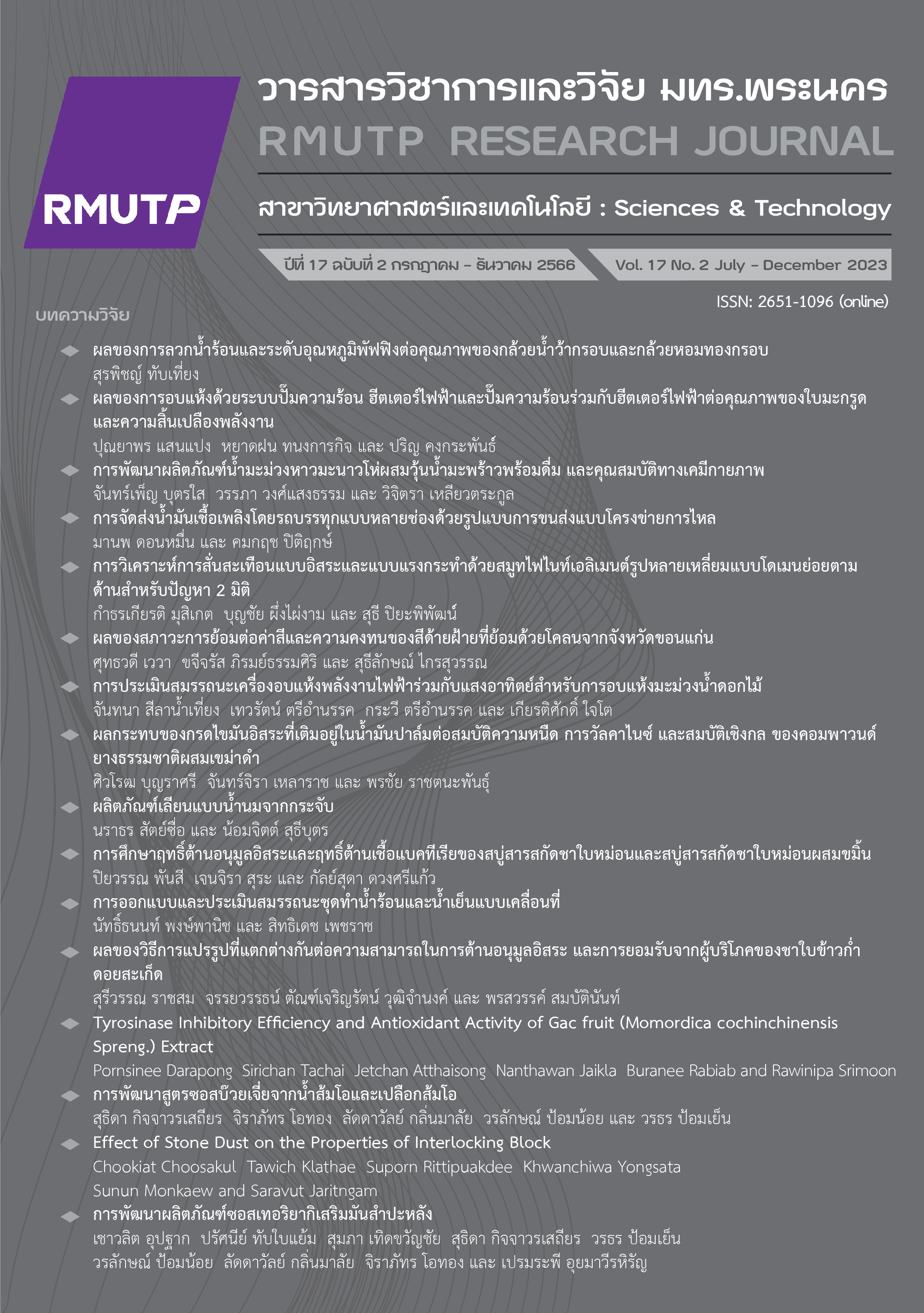การพัฒนาผลิตภัณฑ์น้ำมะม่วงหาวมะนาวโห่ผสมวุ้นน้ำมะพร้าวพร้อมดื่ม และคุณสมบัติทางเคมีกายภาพ
Main Article Content
บทคัดย่อ
มะม่วงหาวมะนาวโห่ มีชื่อวิทยาศาสตร์ว่า Carissa carandas L. เป็นพืชพื้นบ้านของไทยที่ได้รับความสนใจมากขึ้นเนื่องจากมีประโยชน์ต่อร่างกาย งานวิจัยนี้มีวัตถุประสงค์เพื่อพัฒนาผลิตภัณฑ์น้ำมะม่วงหาวมะนาวโห่ผสมวุ้นมะพร้าวพร้อมดื่ม โดยศึกษาสารสำคัญในผลมะม่วงหาวมะนาวโห่ 3 ระยะ ได้แก่ผลดิบ ผลกึ่งสุกและผลสุก พบว่าปริมาณของแข็งที่ละลายได้ทั้งหมด ปริมาณแอนโทไซยานินทั้งหมด และสารประกอบฟีนอลิกทั้งหมด พบสูงสุดในผลสุกเท่ากับ 9.13 องศาบริกซ์, 133.59 มิลลิกรัมไซยานิดินต่อ 100 กรัมตัวอย่าง และ 540 มิลลิกรัมกรดกาลิคต่อ 100 มิลลิลิตรตัวอย่าง ตามลำดับ ผลดิบมีปริมาณกรดสูงสุดร้อยละ 3.99 ผลกึ่งสุกมีปริมาณวิตามินซีสูงสุดเท่ากับ 45.67 มิลลิกรัมต่อ 100 มิลลิลิตรตัวอย่าง การประเมินทางประสาทสัมผัส (9-Pointed Hedonic Scale) น้ำมะม่วงหาวมะนาวโห่พร้อมดื่ม พบว่าผลิตภัณฑ์ที่ได้มีส่วนผสมของน้ำตาลทรายขาวร้อยละ 12 อัตราส่วนของวุ้นมะพร้าวที่เหมาะสมร้อยละ 10 เนื่องจากผู้ชิมให้คะแนนด้านสี รสชาติ และความชอบโดยรวมมากที่สุด ผลิตภัณฑ์ที่ได้มีปริมาณ ใยอาหารร้อยละ 0.02 มีปริมาณกรดทั้งหมดในรูปของกรดซิตริก(ร้อยละ) 5.37 ด้านเคมีมีสารประกอบฟีนอลิก 40.14 mg/100 g และสารแอนโทไซยานิน 27.60 mg/100 g ด้านคุณภาพทางจุลินทรีย์มีค่าไม่เกินเกณฑ์มาตรฐานผลิตภัณฑ์ชุมชน (น้ำมะเม่า มผช. 486/2556)
Article Details

This work is licensed under a Creative Commons Attribution-NonCommercial-NoDerivatives 4.0 International License.
ลิขสิทธ์ ของมหาวิทยาลัยเทคโนโลยีราชมงคลพระนครReferences
S. Simla, “Carissa carandas L.: The fruit mentioned in Thai literature that has many health benefits,” Khon Kean Agr. J., vol. 44, no. 3, pp. 557-566, 2016.
R. Maheshwari, A. Sharma and D. Verma, “Phyto-therapeutic Significance of Karaunda B.,” Environ Pharmacol Life Sci, vol. 1, no. 12, pp. 6-34, 2012.
N. Gumlungpat, A. Charoenpanich and P. Limpachayaporn, “Biological Activity of Carissa Carandas Linn. Young Fruit Exttract on HepG2, HeLa and Human Keratinocyte Cell HaCaT,” Udon Thani Rajabhat University Journal of Science and Technology, vol. 8, no. 2, pp. 33-48, 2020.
K. Sanoppa, T. Poonyavanit and P. Pisuttipong, “Substitution of Sodium Nitrite in Sausages by Pigment Powders from Monascus purpureus Fermented with Nata de Coco,” The Journal of KMUTNB, vol. 31, no. 2, pp. 288-299, 2021.
K. Srisupak, S. Ngoenyen and P. Yuthachit. “A Study on the Optimum Amount of Saccharin for Nata de Coco Production,” Science and Technology Research Journal, vol. 5, No. 2, pp. 7-15, 2020.
A.O.A.C., “Official Methods of Analysis of AOAC International,” Gaithersburg, Md.: Association Official Analytical Chemists, 2000.
S. Fakngoen and S. Meerod, “Extraction and Separation of Anthocyanins from Carissa carandas L.,” in The 4th National Conference KPRU, Kamphaengphet Rajabhat University, Kamphaengphet, 2017, pp. 1002-1011.
N. Buachoon, “Antioxidant Activity and Total Phenolic from Seed and Fruits of Carissa Carandas,” VRU Research and Development Journal Science and Technology, vol. 13, No. 2, pp. 53-63, 2018.
S. Saithi, S. Sakhunkhu and K. Sombun, “Production of Mao (Antidesma bunius) juice mixed with Nata de coco in clear-glass bottle,” RMUTP Research Journal, vol. 10, no. 2, pp. 66-74, 2016.
N. Kumkong and S. Vatanyoopaisarn. “Development of Vinegar Drink from Fermented Indian Gooseberry,” The Journal of KMUTNB, vol. 28, no. 1, pp. 163-174, 2018.
U.S. Food and Drug Administration (USFDA). (2020, June 14). Bacteriological Analytical Manual Online (BAM online): Yeasts, Molds and Mycotoxins. [Online]. Available:https://www.fda.gov/food/laboratory-methods-food/bam-chapter-18yeasts-molds-and-mycotoxins
K. Klinsukhon, U. Sukatta, P. Rukthaworn, L. Khacharat, W. Suravanichnirachorn and P. Neumyem, “Fruit ripening stages of Carissa carandas Linn. on antioxidant and alpha- Glucosidase inhibition activities,” in Proceeding of 55th Kasetsart University Annual Conference, Kasetsart University, Bangkok, 2017, pp. 841-844.
A. Joomwong, “Effect of Maturity Stages on Physical and Chemical Quality of Carissa Carandas Linn.,” Agricultural Sci J., vol. 45, no. 3/1 (Suppl.), pp. 229-232, 2014.
T. Kayyen. “Effect of Maturation Stage on Biological Properties of Carissa carandas,” M.S. Thesis, Dept. Biotechnology Graduate School, Silpakorn Univ., Bangkok, Thailand, 2017.
N. Rattanapanone, Food Analysis Principles, Odian Store, Bangkok, 2011.
P. Rittilert and K. Warin, “Development of Karanda (Carissa carandas L.) Gummy Jelly Product,” Thai Journal of Science and Technology, vol. 9, no. 2, pp. 341-354, 2020.
W. Pewlong, ,S. Sajjabut, S. Singphet and J. Eamsiri, “Influence of Fruit Ripening Stages on the Bioactive Compounds of Carissa carandas,” Agricultural Sci. J., vol. 44, no. 2 (Suppl.), pp. 337-340, 2013.
N. Peamaroon, N. Moonrungsee, A. Boonmee, S. Suwancharoen, T. Kasemsuk and J. Jakmunee. “Phytochemical and xanthine oxidase inhibitory activity of Carissa carandas L. fruit extract,” RMUTP Research Journal, vol. 13, no. 2, pp. 106-118, 2019.
S. Simla, S. Boontang and P. Siritrakulsak. “The evaluation of some Phytochemical content and Antioxidant activity in Carissa carandas L., Khon Kaen Agr. J., vol. 41, Suppl. 1, pp. 602-606, 2013.
S. Parnsakhorn, J. Langkapin, ,P. Jamphung and C Srimas. “The production of malt high anthocyanin powder from rice berry,” Journal of Engineering, RMUTT, vol. 15, no. 2, pp. 41-50, 2017.
C. D. Sae-chan, J. Rinkham, J. Lankaew, V. Visutthithada and S. Sriyam. “Determination of Phenolic Compounds and Antioxidant Activity in Wampee (Clausena lansium (Lour.) Skeels),” Journal of Innovative Technology Research, vol. 4, no. 2, pp. 12–21, 2020.
N. Tangkawattanakul and P. Tantanasrigul, “Role of Vitamin C in the Skin,” J. Dept Med Ser, vol. 44, no. 3, pp. 7–8, 2019.
Thai Community Product Standard, Ma-maow Juice TCPS 486/2556, 2013.

